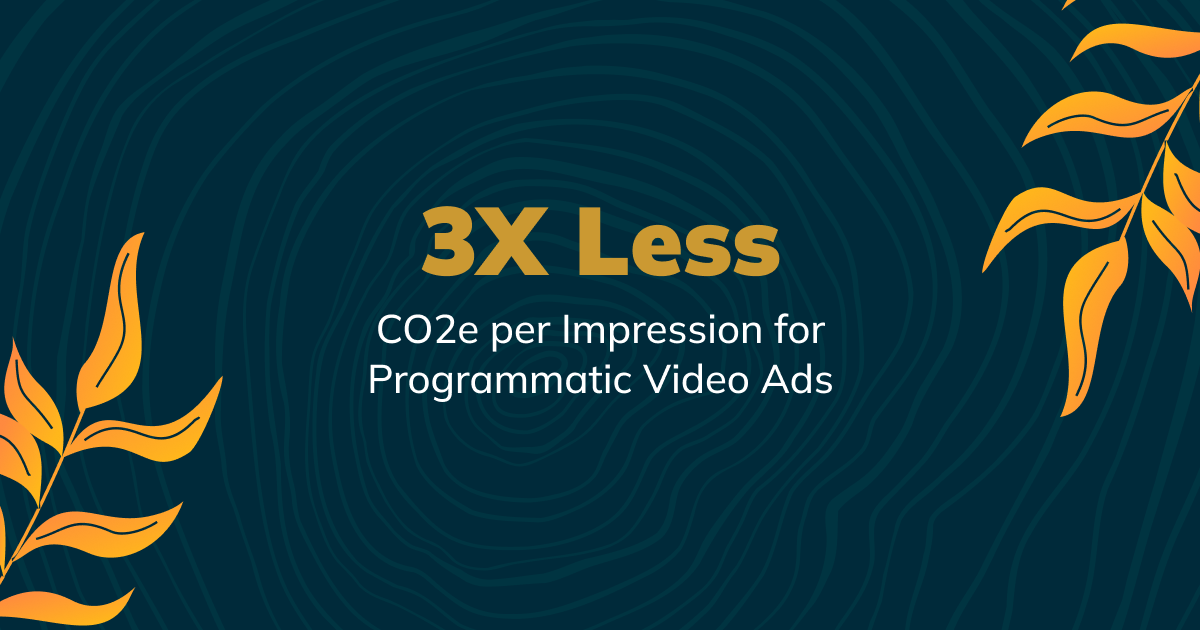Sustainability in digital advertising is no longer a “nice to have”—it’s a must. Consumers, brands, and publishers alike want to ensure their media choices align with an environmentally responsible approach. At GumGum, sustainability is one of our global social impact pillars, and we’re proud to partner with Cedara to measure, reduce, and report carbon emissions from our advertising campaigns. Below, we’ll walk you through our new benchmarking data, how we achieved these results, and what this means for our industry partners looking to run greener campaigns.
Why We Measure Emissions
Measuring greenhouse gas emissions is the first step to reducing them. With the help of Cedara—our carbon intelligence partner—we’re able to collect data on GumGum’s ad delivery and publisher inventory via API integrations and receive our total emissions per campaign. By understanding the carbon footprint of each impression, we can adjust our processes, optimize our inventory strategies, and share actionable insights with our clients.

Key Scores & Industry Comparisons
In our initial analysis, we found that GumGum’s overall emission intensity across impressions is significantly lower than industry benchmarks. These metrics were calculated under the Global Media Sustainability Framework (GMSF)* standards, recognized for providing a holistic and consistent approach to measuring digital ad emissions.
Here’s where GumGum currently stands:
- Programmatic Advertising
- GumGum: 0.67 grams of CO2e per impression
- Industry Benchmark: 4.24 grams of CO2e
- We’re nearly 85% more efficient than typical programmatic ads.

- Direct Advertising
- GumGum: 0.06 grams of CO2e per impression
- Industry Benchmark: 0.66 grams of CO2e
- That’s 90% more efficient than the industry benchmark.

- Video Ads
- Programmatic Video: 1.74 grams of CO2e per impression (vs. 4.83 industry benchmark)
- Direct Video: 1.03 grams of CO2e (vs. 1.25 industry benchmark)

Overall, GumGum’s average intensity measures at 0.48 grams of CO2e per impression—far outperforming the split-industry benchmark of 2.45 grams. These differences highlight the impact of purposeful ad placement, contextual targeting, and behind-the-scenes optimizations.

How GumGum & Cedara Power These Results
Our carbon intelligence partnership with Cedara is designed to make measuring and reducing emissions as effortless as possible.
- Automated Data Flows
- We send our campaign delivery data to Cedara via APIs, and Cedara calculates total emissions per campaign. This includes both programmatic and direct inventory.
- Inventory-Level Insights
- Our publisher inventory data is also shared with Cedara, providing more granular visibility. This allows us to identify which sites and ad formats have higher emissions, empowering us and our partners to make informed decisions about where ads run.
- Easy Green Media Products (GMPs)
- With Cedara’s data, we can offer clients Green Media Products (GMPs) that focus on lower-emission publishers, as well as the option to offset emissions for campaigns. This helps advertisers not only reduce their carbon footprint but also keep pace with sustainability requirements demanded by their customers.
What’s Behind Our Lower Emissions?
Contextual-First Approach:
Rather than relying on heavy data collection methods, GumGum focuses on context. This approach streamlines targeting and reduces redundant data processing, leading to lower carbon footprints.
Optimized Infrastructure:
By continually improving our bidding algorithms and data centers, we reduce unnecessary requests, effectively decreasing emissions in the bidstream.
Inventory Quality Standards:
We exclude certain lower-value or questionable inventory types, like Made for Advertising (MFA) sites, which typically yield higher carbon costs with minimal brand benefit.
Making Sustainability a Team Effort
We know that reducing our own emissions is just one piece of the puzzle. Our mission is to help clients, agencies, and publishers minimize their carbon footprints too. Through our partnership with Cedara, we provide:
- Transparent Reporting: Clients can receive one-off campaign emissions reports or more frequent updates as needed, so they know precisely how they’re performing.
- Offset & Reduction Options: By contributing a small cost-per-thousand (CPM) uplift, advertisers can offset their campaigns’ carbon footprint via Cedara’s Reduction Marketplace.
- Future Innovations: We’re exploring new science-based emissions reduction targets as part of the Science Based Targets initiative (SBTi) to guide our journey toward net zero.
How You Can Partner with GumGum for Greener Campaigns
If you’re looking to adopt a more sustainable approach to digital advertising, here are a few steps to consider:
- Choose Green Media Products: Opt for GumGum’s GMP offerings and embrace contextual solutions for targeting.
- Offset Your Campaign Emissions: Take advantage of Cedara’s marketplace to neutralize any unavoidable emissions.
- Ask for Emissions Reporting: By understanding your campaign’s carbon performance, you can collaborate with us to improve it further.
The Road Ahead
From building a global, contextual-first platform to collaborating with partners like Cedara, we’re doubling down on our commitment to environmental responsibility. By continuing to measure and share our progress, we aim to inspire the wider adtech ecosystem to collectively reduce its carbon footprint.
*GMSF v1.1 programmatic industry benchmark leverages industry default values from the SRI & Alliance Digitale framework, since the GMSF had yet to define default values in their framework. The SRI & Alliance Digitale framework has served as the foundation for the GMSF methodology for Digital.










